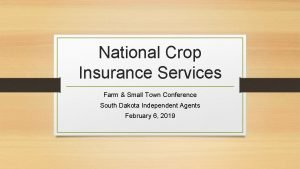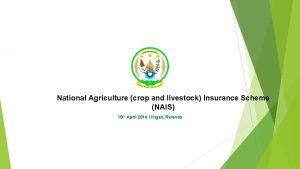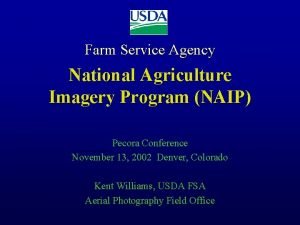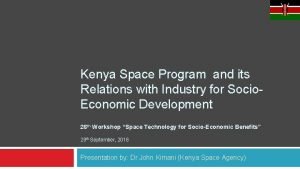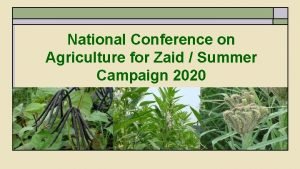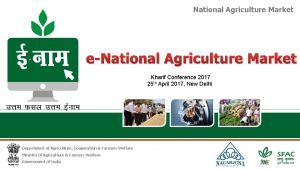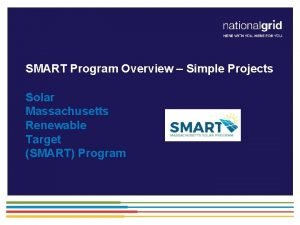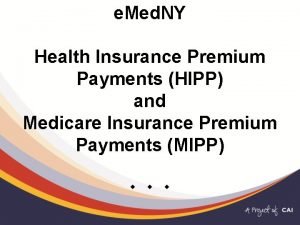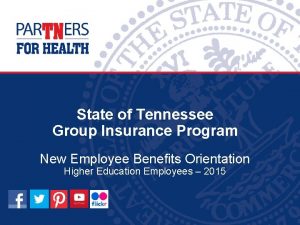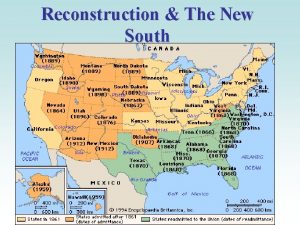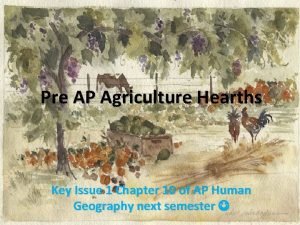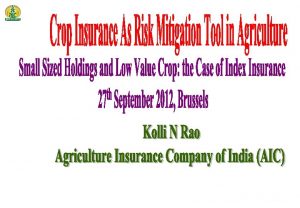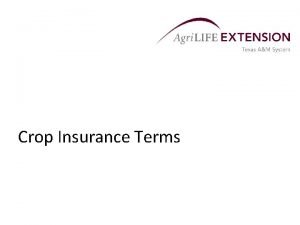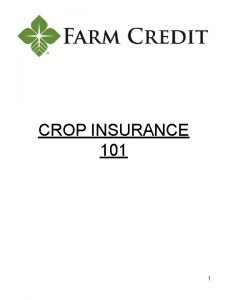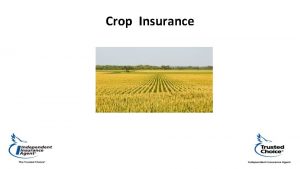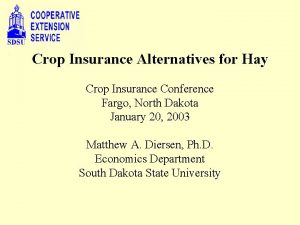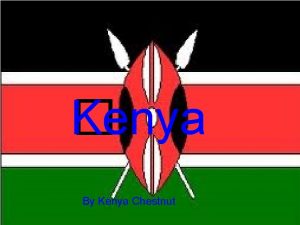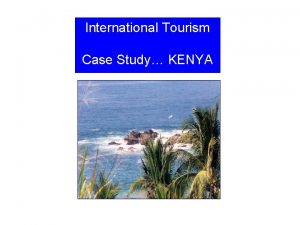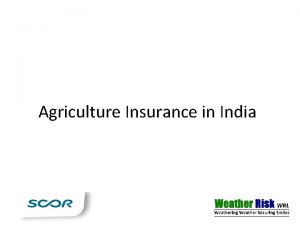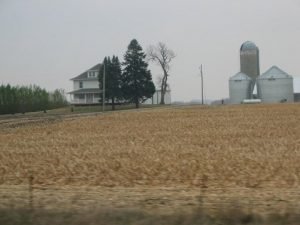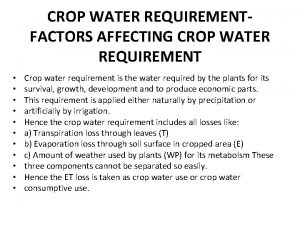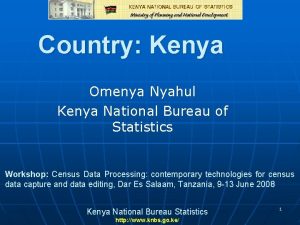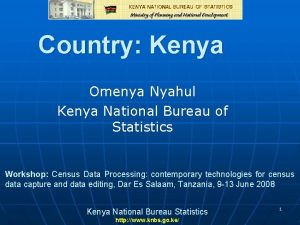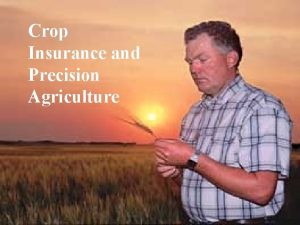NATIONAL AGRICULTURE INSURANCE PROGRAM OVERVIEW OF KENYA CROP




























- Slides: 28

NATIONAL AGRICULTURE INSURANCE PROGRAM OVERVIEW OF KENYA CROP INSURANCE PROGRAMME Tom Dienya tm. dienya@gmail. com +254720873855

Outline 1. Introduction; genesis of agric insurance programme in Kenya 2. Why Kenya Agriculture Insurance programme 3. Public private Sector Model for Agric Insurance 4. Crop Insurance: the Area Yield Index Insurance Programme 5. Achievements; lessons learnt 6. Conclusion

Introduction Size: 581, 309 km 2 (224, 445 sq million) Population : about 46 Million Arid land- 58% Semi Arid- 21% Medium-high potential land- 13% Agriculture- Main source of livelihood; contributes 30% of GDP Small-holder farmers: 75%

Genesis of Agric Insurance in Kenya Agricultural producers progressively facing more risks 1. Climate Change Vs rain-fed agric • Increasing unreliable rainfall, droughts, floods; • New diseases; new pests 2. Majority smallholder farmers: • Vulnerable to shocks • Low resilience- Difficulty in bouncing back after a shock 3. Low Agric productivity correlated to low investment in agric: Access to credit and Inputs • Low credit due to risks in agric

Genesis of Agric Insurance in Kenya Challenges of sustainable Agric risks Management • Since 1970, Kenya has experienced a total of 41 major floods affecting 6. 9 million people • Since 1970, 13 major drought events • Between 2008 and 2017: estimated KShs 699 billion in livestock losses and KShs 121 billion in crop losses • Over the past 12 years, the Government of Kenya has spent on average KShs 4. 2 billion per year on disaster relief funding • In 2017: Ksh 16 Billion used; Maize floor subsidy: 9 Billion

Genesis of Agric Insurance in Kenya Standard response mechanism- not effective 1) Resource Mobilization; budgets re 2) 3) 4) • - allocation Food aid/Cash Aid to affected population Post-drought livestock restocking Feed; seeds aid Key Problems: Slow Expensive Disrupted budget; national plans Beneficiaries targeting challenges Continuous food aid: reinforce external dependency

Why Agric Insurance as alternative Overall Purpose of Agric Insurance: To Reduce impact of risks in Agric • Build resilience of smallholder farmers: ability to remain in production; bounce back after set-back • Increase farmers’ access to credit, and inputs • Improve agricultural productivity, transition from subsistence to commercial farming • Eliminate post disaster response challenges eg revised national funds, aid dependency, etc • Provide social protection to the poor Options of Insurance • Conventional (individual) insurance • Government supported Insurance

Private Public Partnership Model • For several years Kenya government investigated options to initiate large-scale agriculture insurance in Kenya • In 2013, Agric Insurance formed part of Jubilee Gov party Manifesto • 2014 - 2015: The Gov commissioned the World Bank to undertake comprehensive Agriculture Insurance Solutions Appraisal and Policy Review for Kenya. • World Bank: proposed development of large scale Public-Private Partnerships (PPPs) arrangement for crops and livestock insurance in Kenya. • Livestock Insurance: larger focus on the arid, pastoral regions where livestock is main source of livelihood • Crops insurance programme: Mainly none ASAL counties

Private Public Partnership Model Public Private Participation model • Issues: How to make insurance, cheap, accessible, sustainable, popular with small scale farmers Actors • Government: National; county • Ministry of agriculture, Insurance Regulation Authority; Kenya Reinsurance company Private Sector • Private Insurance companies (52 in Kenya); Financial institutions • Dev Partners: World Bank • None State Actors: Financial Sector Deepening Kenya, Syngenta EA, One Acre Fund, etc

Private Public Partnership Model Public Private Participation model • Govt support: data management, farmers mobilization, capacity development; subsidies, Gov Reinsurance support, policy and regulatory framework • Private Insurance companies: form pool; develop and market insurance products; research/innovations; private reinsurance • Financial institutions: bundle credit lending to insurance Typical examples: • Dev Partners: provide other • India; Mongolia; Spain, United States technical support • On a global basis, only 7% of transaction volume is purely private

Area Yield Index Insurance (AYII) • Type of crop insurance selected for up-scaling and direct gov support • AYII- Insurance of farmers grouped in homogeneous geographical areas/units with near-similar yields of the insured crop • Historical yield of the crop in each identified homogeneous area form the index used for developing product (sum assured, premium cost), and lose assessment • Farmers purchase insurance, pay premium individually. However, lose assessment and payouts are determined by the data collected from the homogeneous areas

Area Yield Index Insurance AYII Process • Identify the crop and counties to be covered • Create the homogeneous Unit Areas of Insurance (UAI) • Gather and clean historical data • Develop insurance product and set premium cost • Undertake farmers’ awareness creation • Undertake product underwriting (sale to farmers) • Undertake crop cutting at end of season to determine actual yields • Decide on payout or not • Conclude the season and prepare for next season

AYII-Selection of Crop Consideration: • Practice by many farmers • Food security • Contribution to agricultural value addition • Availability of Data Note: 1. Choice should be Demand Driven by counties 2. Private insurance allowed to insure other crops under traditional arrangements

AYII-Defining UAI • Example: Narok County • In the hypothetical administrative area of “Narok South” sub-county as a UAI; • The average historical yield of insured crop is established. • But how homogeneous is Narok South Sub-county? . Boundaries of a hypothetical “Narok South” Sub-county

AYII-Definition of UAI…. cont • How homogeneous is Narok South sub-county for a crop eg wheat? • Or segment to smaller homogeneous areas (Wards, or sub-location)? • For ease smaller UAI, try to follow existing admin boundaries Boundaries of hypothetical sub-UAIs Boundaries of hypothetical “Narok South”

AYII- Developed product Product Example: Kirinyaga County; Mwea West Sub-county Maize Long Rains Season 2017; UAI= Unit Area of Insurance UAI NAME Ward UAI-1 UAI-2 UAI-3 UAI-4 UAI-5 UAI-6 UAI-7 Sub. Historical Insuran Trigger Ave Maize Total Premium Subsidy Farmer location Yields (90 Kg ce Level Price Sum (Ksh) Go. K Pay bags/ acre) Cover (Bags/ (Ksh/90 Kg) Assured cost (Ksh) Level Acre) (Ksh) per bag; and per acre Mukure Kianjang’ 8. 25 70% 5. 8 2, 400 13, 9 83 4 a 20 5 418 18 Mukure Gitaku 8. 25 70% 5. 8 2, 400 13, 9 83 4 20 5 418 18 Kiine Kithumbu 8 70% 5. 6 2, 400 13, 4 80 4 4 40 6 03 03 Kiine Maitharui 8 70% 5. 6 2, 400 13, 4 80 4 4 40 6 03 03 Kariti Sagana 9. 5 70% 6. 7 2, 400 16, 0 96 4 4 80 5 82 82 Kariti Gacharu 10 70% 7 2, 400 16, 8 1, 00 5 5 00 8 04 04 Kariti Thigirichi 9. 5 70% 6. 7 2, 400 16, 0 96 4 Sale window: Not more than 1 month after planting/sowing week 80 5 482 82

Loss Assessment Yield assessment based on Crop Cutting • • • Purchase of Crop Cutting tools: tape measure, weighing scales, moisture meters, Tablets/ smart phones Who does CC: Gov Training on crop cutting Sampling of Farmers’ within UAI Actual crop cutting; Crop Cutting auditing by select team Data analysis and actual yield determination; Payout determination Results announcement to farmers Pay- At most 1 month after results announcement

AYII- Determination of Payouts

Area Yield Index Insurance Role of Government • Political will; Resource mobilization • Stakeholders coordination • Identify the crop and counties to be covered • Create the homogeneous Unit Areas of Insurance (UAI) • Gather and clean historical data • Undertake farmers’ awareness creation • Capacity building • Pay subsidy: Half of premium costs; 0. 5 acres to 20 acres • Loss assessment: undertake crop cutting at end of season to determine actual yields • Support loss assessment auditing; arbitrations • Policy, regulations • Re-insurance

Area Yield Index Insurance Role of Insurance companies • Undertake farmers’ awareness creation • Products Development; innovations • Capacity building • Undertake product underwriting (sale to farmers) • Pay farmers where applicable

Advantages of AYII 1) 2) 3) 4) Multi-peril; covers several risks Easy to understand explain to farmers Useful for covering large number of farmers Minimal adverse selection or moral hazards: AYII does not depend on individuals; individuals' behavior does not affect the programme adversely 5) Cheap administrative costs for insurance companies 6) Cheaper premium compared to others

Disadvantages of AYII Prone to Basis Risk-Defined as the potential paying farmer who does not deserve pay; or not paying one who deserves pay within the insured area. Sources of Basis risk under AYII: 1) Localized perils (e. g. hailstones, wildlife or flooding by a nearby river), that do not impact on the UAI average yield; 2) Creation of Non homogeneous UAIs; inaccurate data Basis risk can be minimized by: • Proper identification of the homogeneous producing zones(UAIs) 1) Improve data accuracy and reliability

Achievements 1) No of crops covered: Maize; moving to other crops soon 2) Year 1: Counties= 3; insured farmers= 900; Year 2= 10 Counties covered; over 230, 000 farmers Year 3: 20 counties; 303, 000 farmers Target: 5 Million farmers by 2020 3) Estimated Gov annual budget: Ksh 350 Million; to scale to 2. 2 Billion in next 4 years 4) Development of ICT based data management system

Overall Challenges • Few Insurance companies interested; low capacity for mass sale of product (short sale window); insurance companies mainly in major towns not rural areas • Insurance companies avoiding drier/risky counties • No local re-insurance company supporting agric insurance • Little competition; low product diversification and options • Companies avoiding drier/risky counties • Slow, late payments to farmers • Farmers not sure about insurance; need more education • High cost of data collection; crop cutting • Insurance regulation: Agric insurance under “Miscellaneous” • Lack of policy

Lessons for Improvement • Working with farmer aggregators eg cooperative societies; 1 acre fund to get numbers • Bringing on board Banks- Equity Bank; Agric Finance Corporation to bundle insurance with agric credit • Bundling Agric Insurance with Gov inputs subsidy programmes • Work closely with Insurance Regulation Authority • Work on Policy • Working with counties to increase subsidy funding • Need for National Re-insurance company eg Kenya Re-insurance company • Need for Gov protection in the short run- taxes, tender awards, • Need for opening up to competitions in the long run • Calling on other re-insurance companies (currently SWISS Re) • Compel insurance Co to take both risky and less risky counties. Aggregating counties; combining Risky with less risky counties • Use of ICT systems to improve efficiency

Lessons Increase use of ICT q To Minimize manual data collection, reports, q Improve accuracy of data analysis q Improve timeliness of payouts

Conclusion 1) Agriculture insurance has huge potential in Africa; big business for insurance companies 2) It takes time to scale up and need for strong government support 3) Need to encourage local insurance companies at initial stages 4) Need to improve policy and legal framework to support agriculture insurance 5) Timely payment to farmers; reducing cost of insurance to farmers 6) Promotion of Weather Index for Hort Crops- due to difficulties of crop cutting as done for cereals

The End…… THANK YOU
 National crop insurance services
National crop insurance services National agriculture insurance scheme
National agriculture insurance scheme Crop insurance yield descriptors
Crop insurance yield descriptors National agriculture imagery program
National agriculture imagery program Goals of ntep
Goals of ntep Agriculture insurance in sri lanka
Agriculture insurance in sri lanka Kenya space program
Kenya space program Fire insurance contract
Fire insurance contract National conference on agriculture for summer campaign
National conference on agriculture for summer campaign Nmsa guidelines
Nmsa guidelines National agriculture market
National agriculture market Sbic program
Sbic program Ma smart program overview
Ma smart program overview Ndis school leaver employment supports
Ndis school leaver employment supports National disability insurance agency
National disability insurance agency National insurance number
National insurance number Health insurance premium payment program ny
Health insurance premium payment program ny Tennessee state group insurance program
Tennessee state group insurance program Missouri state health insurance assistance program
Missouri state health insurance assistance program Habitational insurance program
Habitational insurance program Insurance program administrators
Insurance program administrators South carolina the beautiful palmetto state
South carolina the beautiful palmetto state Crop lien system
Crop lien system Crop lien system
Crop lien system Retting of fibres meaning in urdu
Retting of fibres meaning in urdu Seed agriculture hearths
Seed agriculture hearths Icon di microsoft word
Icon di microsoft word Crop lien system
Crop lien system Illinois crop improvement association
Illinois crop improvement association
